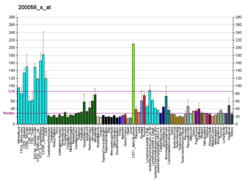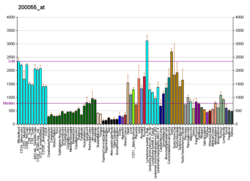TAF10
Transcription initiation factor TFIID subunit 10 is a protein that in humans is encoded by the TAF10 gene.[5][6]
Function
Initiation of transcription by RNA polymerase II requires the activities of more than 70 polypeptides. The protein that coordinates these activities is transcription factor IID (TFIID), which binds to the core promoter to position the polymerase properly, serves as the scaffold for assembly of the remainder of the transcription complex, and acts as a channel for regulatory signals. TFIID is composed of the TATA-binding protein (TBP) and a group of evolutionarily conserved proteins known as TBP-associated factors or TAFs. TAFs may participate in basal transcription, serve as coactivators, function in promoter recognition or modify general transcription factors (GTFs) to facilitate complex assembly and transcription initiation. This gene encodes one of the small subunits of TFIID that is associated with a subset of TFIID complexes. Studies with human and mammalian cells have shown that this subunit is required for transcriptional activation by the estrogen receptor, for progression through the cell cycle, and may also be required for certain cellular differentiation programs.[6]
Interactions
TAF10 has been shown to interact with TAF9,[7] Transcription initiation protein SPT3 homolog,[7][8] TAF13[9] and TATA binding protein.[10][11]
References
- GRCh38: Ensembl release 89: ENSG00000166337 - Ensembl, May 2017
- GRCm38: Ensembl release 89: ENSMUSG00000043866 - Ensembl, May 2017
- "Human PubMed Reference:". National Center for Biotechnology Information, U.S. National Library of Medicine.
- "Mouse PubMed Reference:". National Center for Biotechnology Information, U.S. National Library of Medicine.
- Jacq X, Brou C, Lutz Y, Davidson I, Chambon P, Tora L (November 1994). "Human TAFII30 is present in a distinct TFIID complex and is required for transcriptional activation by the estrogen receptor". Cell. 79 (1): 107–17. doi:10.1016/0092-8674(94)90404-9. PMID 7923369.
- "Entrez Gene: TAF10 TAF10 RNA polymerase II, TATA box binding protein (TBP)-associated factor, 30kDa".
- Martinez E, Palhan VB, Tjernberg A, Lymar ES, Gamper AM, Kundu TK, Chait BT, Roeder RG (October 2001). "Human STAGA complex is a chromatin-acetylating transcription coactivator that interacts with pre-mRNA splicing and DNA damage-binding factors in vivo". Mol. Cell. Biol. 21 (20): 6782–95. doi:10.1128/MCB.21.20.6782-6795.2001. PMC 99856. PMID 11564863.
- Brand M, Moggs JG, Oulad-Abdelghani M, Lejeune F, Dilworth FJ, Stevenin J, Almouzni G, Tora L (June 2001). "UV-damaged DNA-binding protein in the TFTC complex links DNA damage recognition to nucleosome acetylation". EMBO J. 20 (12): 3187–96. doi:10.1093/emboj/20.12.3187. PMC 150203. PMID 11406595.
- Mengus G, May M, Jacq X, Staub A, Tora L, Chambon P, Davidson I (April 1995). "Cloning and characterization of hTAFII18, hTAFII20 and hTAFII28: three subunits of the human transcription factor TFIID". EMBO J. 14 (7): 1520–31. doi:10.1002/j.1460-2075.1995.tb07138.x. PMC 398239. PMID 7729427.
- Bellorini M, Lee DK, Dantonel JC, Zemzoumi K, Roeder RG, Tora L, Mantovani R (June 1997). "CCAAT binding NF-Y-TBP interactions: NF-YB and NF-YC require short domains adjacent to their histone fold motifs for association with TBP basic residues". Nucleic Acids Res. 25 (11): 2174–81. doi:10.1093/nar/25.11.2174. PMC 146709. PMID 9153318.
- Ruppert S, Wang EH, Tjian R (March 1993). "Cloning and expression of human TAFII250: a TBP-associated factor implicated in cell-cycle regulation". Nature. 362 (6416): 175–9. doi:10.1038/362175a0. PMID 7680771.
Further reading
- Mengus G, May M, Jacq X, Staub A, Tora L, Chambon P, Davidson I (1995). "Cloning and characterization of hTAFII18, hTAFII20 and hTAFII28: three subunits of the human transcription factor TFIID". EMBO J. 14 (7): 1520–31. doi:10.1002/j.1460-2075.1995.tb07138.x. PMC 398239. PMID 7729427.
- Zhou Q, Sharp PA (1995). "Novel mechanism and factor for regulation by HIV-1 Tat". EMBO J. 14 (2): 321–8. doi:10.1002/j.1460-2075.1995.tb07006.x. PMC 398086. PMID 7835343.
- Parada CA, Yoon JB, Roeder RG (1995). "A novel LBP-1-mediated restriction of HIV-1 transcription at the level of elongation in vitro". J. Biol. Chem. 270 (5): 2274–83. doi:10.1074/jbc.270.5.2274. PMID 7836461.
- Ou SH, Garcia-Martínez LF, Paulssen EJ, Gaynor RB (1994). "Role of flanking E box motifs in human immunodeficiency virus type 1 TATA element function". J. Virol. 68 (11): 7188–99. doi:10.1128/JVI.68.11.7188-7199.1994. PMC 237158. PMID 7933101.
- Kashanchi F, Piras G, Radonovich MF, Duvall JF, Fattaey A, Chiang CM, Roeder RG, Brady JN (1994). "Direct interaction of human TFIID with the HIV-1 transactivator tat". Nature. 367 (6460): 295–9. doi:10.1038/367295a0. PMID 8121496.
- Scheer E, Mattei MG, Jacq X, Chambon P, Tora L (1995). "Organization and chromosomal localization of the gene (TAF2H) encoding the human TBP-associated factor II 30 (TAFII30)". Genomics. 29 (1): 269–72. doi:10.1006/geno.1995.1243. PMID 8530084.
- vom Baur E, Zechel C, Heery D, Heine MJ, Garnier JM, Vivat V, Le Douarin B, Gronemeyer H, Chambon P, Losson R (1996). "Differential ligand-dependent interactions between the AF-2 activating domain of nuclear receptors and the putative transcriptional intermediary factors mSUG1 and TIF1". EMBO J. 15 (1): 110–24. doi:10.1002/j.1460-2075.1996.tb00339.x. PMC 449923. PMID 8598193.
- Wang Z, Morris GF, Rice AP, Xiong W, Morris CB (1996). "Wild-type and transactivation-defective mutants of human immunodeficiency virus type 1 Tat protein bind human TATA-binding protein in vitro". J. Acquir. Immune Defic. Syndr. Hum. Retrovirol. 12 (2): 128–38. doi:10.1097/00042560-199606010-00005. PMID 8680883.
- Pendergrast PS, Morrison D, Tansey WP, Hernandez N (1996). "Mutations in the carboxy-terminal domain of TBP affect the synthesis of human immunodeficiency virus type 1 full-length and short transcripts similarly". J. Virol. 70 (8): 5025–34. doi:10.1128/JVI.70.8.5025-5034.1996. PMC 190456. PMID 8764009.
- Kashanchi F, Khleif SN, Duvall JF, Sadaie MR, Radonovich MF, Cho M, Martin MA, Chen SY, Weinmann R, Brady JN (1996). "Interaction of human immunodeficiency virus type 1 Tat with a unique site of TFIID inhibits negative cofactor Dr1 and stabilizes the TFIID-TFIIA complex". J. Virol. 70 (8): 5503–10. doi:10.1128/JVI.70.8.5503-5510.1996. PMC 190508. PMID 8764062.
- Zhou Q, Sharp PA (1996). "Tat-SF1: cofactor for stimulation of transcriptional elongation by HIV-1 Tat". Science. 274 (5287): 605–10. Bibcode:1996Sci...274..605Z. doi:10.1126/science.274.5287.605. PMID 8849451.
- García-Martínez LF, Ivanov D, Gaynor RB (1997). "Association of Tat with purified HIV-1 and HIV-2 transcription preinitiation complexes". J. Biol. Chem. 272 (11): 6951–8. doi:10.1074/jbc.272.11.6951. PMID 9054383.
- Chéhensse V, Boulvin C, Luce S, Tora L, Junien C, Henry I (1997). "Assignment of the human TAFII30 gene (TAF2H) to human chromosome band 11p15.3 using somatic cell hybrids". Cytogenet. Cell Genet. 76 (1–2): 41–2. doi:10.1159/000134510. PMID 9154123.
- Ogryzko VV, Kotani T, Zhang X, Schiltz RL, Howard T, Yang XJ, Howard BH, Qin J, Nakatani Y (1998). "Histone-like TAFs within the PCAF histone acetylase complex". Cell. 94 (1): 35–44. doi:10.1016/S0092-8674(00)81219-2. PMID 9674425.
- Vassilev A, Yamauchi J, Kotani T, Prives C, Avantaggiati ML, Qin J, Nakatani Y (1998). "The 400 kDa subunit of the PCAF histone acetylase complex belongs to the ATM superfamily". Mol. Cell. 2 (6): 869–75. doi:10.1016/S1097-2765(00)80301-9. PMID 9885574.
- Brand M, Yamamoto K, Staub A, Tora L (1999). "Identification of TATA-binding protein-free TAFII-containing complex subunits suggests a role in nucleosome acetylation and signal transduction". J. Biol. Chem. 274 (26): 18285–9. doi:10.1074/jbc.274.26.18285. PMID 10373431.
- Metzger D, Scheer E, Soldatov A, Tora L (1999). "Mammalian TAF(II)30 is required for cell cycle progression and specific cellular differentiation programmes". EMBO J. 18 (17): 4823–34. doi:10.1093/emboj/18.17.4823. PMC 1171554. PMID 10469660.
- Brand M, Moggs JG, Oulad-Abdelghani M, Lejeune F, Dilworth FJ, Stevenin J, Almouzni G, Tora L (2001). "UV-damaged DNA-binding protein in the TFTC complex links DNA damage recognition to nucleosome acetylation". EMBO J. 20 (12): 3187–96. doi:10.1093/emboj/20.12.3187. PMC 150203. PMID 11406595.
- Gangloff YG, Pointud JC, Thuault S, Carré L, Romier C, Muratoglu S, Brand M, Tora L, Couderc JL, Davidson I (2001). "The TFIID components human TAF(II)140 and Drosophila BIP2 (TAF(II)155) are novel metazoan homologues of yeast TAF(II)47 containing a histone fold and a PHD finger". Mol. Cell. Biol. 21 (15): 5109–21. doi:10.1128/MCB.21.15.5109-5121.2001. PMC 87236. PMID 11438666.





